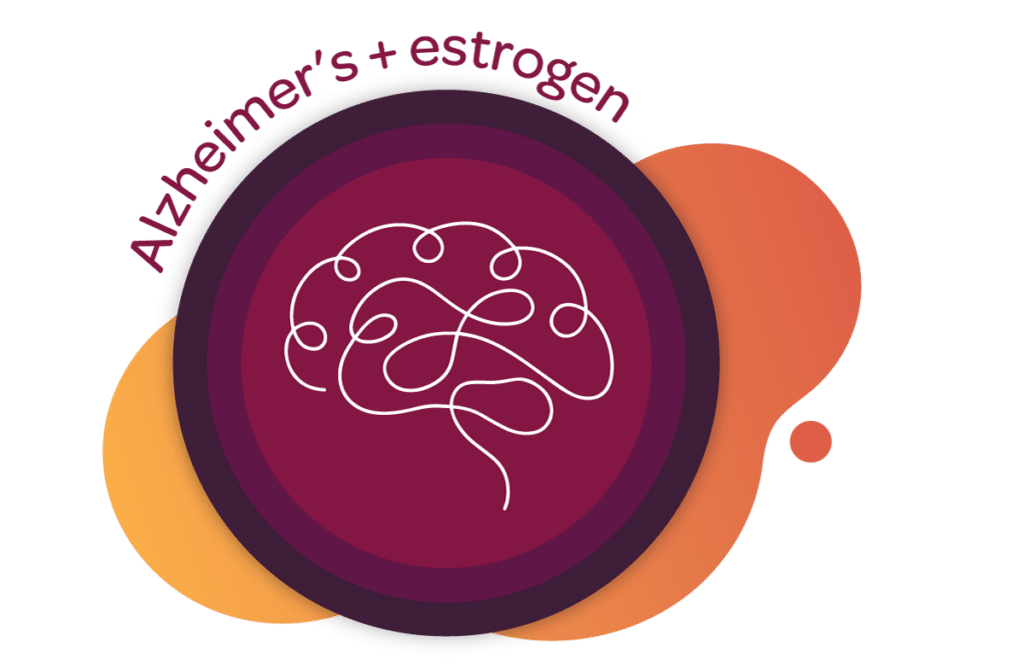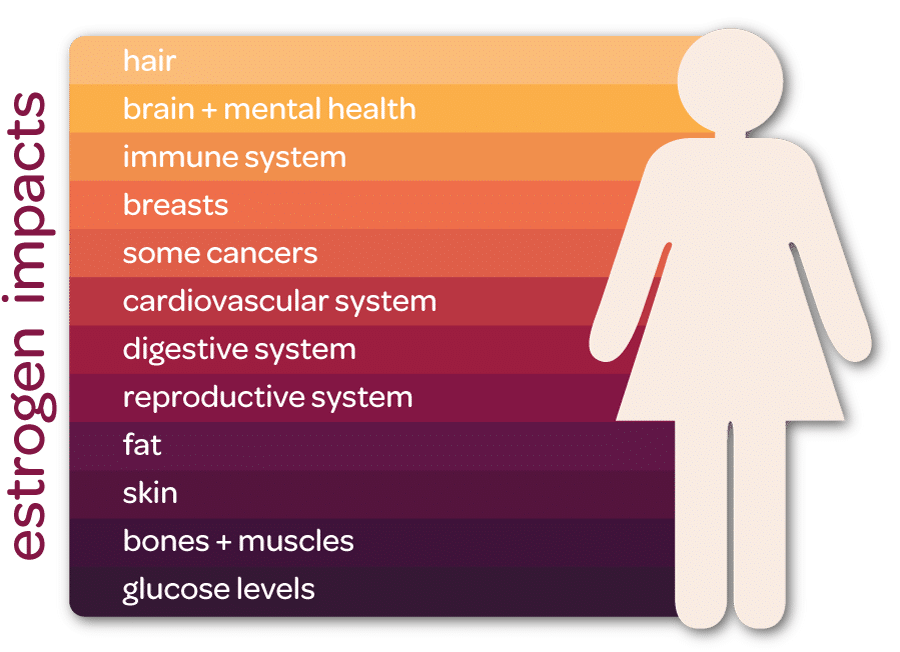
“People think it’s an old-age person’s disease. It’s like cancer was 25 years ago: You didn’t mention the C word. Cancer activists have done an excellent job of destigmatizing it, putting it out there, and making it a disorder that needs attention. Alzheimer’s is still behind the eight ball on that score.”
– Dr. Ronald Petersen
In the fall of 2023, researchers at Weill Cornell Medicine1 published the results of their meta-analysis research into the link between estrogen and Alzheimer’s disease. Through their review of six different research studies, they found a link exists between estrogen and Alzheimer’s. While unable to determine the exact link, they were encouraged to confirm one and advised on future avenues of research. Before digging into the research findings, we’re going to cover what Alzheimer’s is, what estrogen is, and why they both matter in women’s heath.
What is Alzheimer’s disease?
Alzheimer’s is a progressive disease of the brain.2 Patients slowly lose their memories, cognitive abilities, and the ability to care for themselves. According to the Alzheimer’s Association, an estimated 6.9 million Americans currently live with Alzheimer’s.3 We all have a 1 in 9 chance of developing this form of dementia at 65 years old. As we age, our risk increases. Women are more likely than men to develop Alzheimer’s. The higher risk of Alzheimer’s in women suggests an association between hormone loss and Alzheimer’s, as men do not lose hormones as women do.
Stages Alzheimer’s Disease
Stage 1
Memory issues begin, but they do not interfere with daily life
Stage 2
Worsening memory, minor difficulties performing daily tasks, and personality changes. Diagnosis is often made during this stage.
Stage 3
Short-term memory loss, hallucinations, paranoia, aggression, and trouble with impulse control
Stage 4
Inability to care for self, often bed-bound and non-verbal
What is going on in the Alzheimer’s brain?
Damage to the brain from Alzheimer’s disease can begin up to 22 years before a diagnosis is made. Current research is working to pinpoint how to detect these changes and when to start testing for them. The damage starts small with individual cells.4 It spreads to other nearby cells and eventually leads to cell death. The disease continues to grow, affecting more and more cells.
Plaques and Tangles
Besides the damage to the cells themselves, large amounts of two different forms of protein begin to be deposited in the brains of those with Alzheimer’s disease – plaques and tangles. Most of us will develop these as we age, but not in the amount or the pattern of those with Alzheimer’s. Their exact role in the disease is not fully understood, but scientists are making strides in discovering their purpose.
Plaques – Protein fragments (beta-amyloid) are deposited between brain cells and continue to grow as Alzheimer’s progresses
Tangles – Twisted protein fibers (Tau) build up inside the cells and cause damage.
What is estrogen?
Estrogen is a hormone that helps develop and maintain female characteristics and reproductive functions.5 While we know much of what estrogen does and that it affects every area of a woman’s body, we are still discovering its full impact.

Estrogen and Alzheimer’s research
Overview of the research
From previous research, estrogen was found to protect the brain in some way for women.6 However, the studies could not pinpoint exactly how estrogen does this, nor the role it plays in preventing the development of Alzheimer’s. In the hopes of discovering a clue to this role, the Cornell researchers examined data from several studies discussing this link.
Performing a meta-analysis (examination and conclusion compilation of several different research studies) on clinical trials and observational reports, the researchers followed the data from over 6 million women.
Randomized Control Trial (clinical trials)
- A study done that takes many similar people and randomly places them into different groups to test a drug or treatment, considered the gold standard for research
Observational research
- A study done by collecting data from participants
The research conclusion
Two conclusions were drawn from the meta-analysis:
- The clinical trials showed estrogen replacement therapy did not affect the development of Alzheimer’s.
- The observational studies showed estrogen replacement therapy decreased the risk of Alzheimer’s.
As they continued their review of the different studies, one fact stood out. The age a woman started estrogen replacement therapy appeared to be the main difference between the two different types of research studies. In the observational studies, many women began estrogen replacement therapy around the time of menopause, which is normally when it is taken. While, for those in the clinical trials, estrogen replacement therapy started after menopause, ages 65 or older, which is not normally the way estrogen therapy is taken.
Future research
The researchers point out that the differences between the clinical trials and observational studies are significant and need to be explored. Both types of studies had different conclusions: in one estrogen is protective, and in the other, it does not seem to matter.
Research into the effect estrogen has on Alzheimer’s is a difficult experiment, time-wise. Menopause occurs around the age of 50 for most women. Alzheimer’s does not typically show up until 15 years later. A long-term study to learn whether an earlier start to estrogen replacement can reduce the risk of developing Alzheimer’s is needed. Since 60% of Alzheimer’s patients are women, this study is critically important.
Possible future research questions
The study by Cornell Weill Medicine pointed to a variable left out of past studies and raised more questions. Future research is necessary to answer questions, like:
- What effect does estrogen therapy have on Alzheimer’s?
- Is estrogen alone good enough, or should progesterone be included in menopausal hormone therapy?
- When should estrogen replacement therapy be started to have the greatest impact on decreasing the risks of developing Alzheimer’s?
- How exactly does estrogen protect the brain and what does its removal at menopause do to the brain?
Our continuing support of estrogen replacement therapy
The discovery of the KRAS-variant and the increased risk those who carry it have of developing breast cancer when estrogen levels drop after menopause has made us at MiraKind passionate about research into the effects of the loss of estrogen on a woman’s body. We are excited to read the research of others with the same passion. We look forward to seeing where this research takes them in the future and what we will learn about the connection between estrogen and Alzheimer’s.
Further Reading
- Women’s Alzheimer’s Movement
- Menopause
- Menopause & Myths about Menopausal Hormone Therapy
- Let’s learn more about Menopausal Hormone Therapy – together!
- Menopause and mental health
- What are “Normal” Estrogen Levels in Women?
- MHT + The KRAS-variant
References
- https://www.frontiersin.org/articles/10.3389/fnagi.2023.1260427/full
- https://www.nia.nih.gov/health/alzheimers-and-dementia/alzheimers-disease-fact-sheet
- https://www.alz.org/media/documents/alzheimers-facts-and-figures.pdf
- https://www.alz.org/alzheimers-dementia/what-is-alzheimers
- https://www.cancer.gov/publications/dictionaries/cancer-terms/def/estrogen
- https://www.ncbi.nlm.nih.gov/pmc/articles/PMC2048656/#R186




Leave a Reply